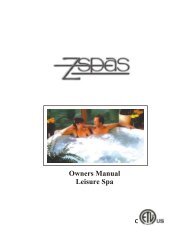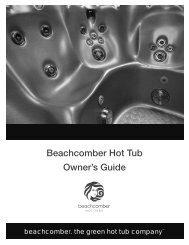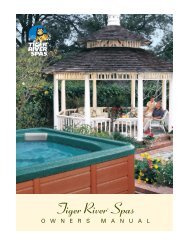Owner’s Manual
2002 - All Seasons Spa
2002 - All Seasons Spa
Create successful ePaper yourself
Turn your PDF publications into a flip-book with our unique Google optimized e-Paper software.
3. Locate the ozonator in the equipment compartment and unplug the ozonator from the control box.<br />
4. Place 16 ounces of white vinegar into a container such as a cup or bucket. Place the container on the equipment compartment floor. NOTE:<br />
White vinegar will not damage any of the spa components.<br />
5. Carefully loosen the long Norprene ® tubing to the bottom of the ozonator. A liquid substance may be found inside the tubing. If a liquid<br />
substance is present, BE CERTAIN NOT TO COME INTO CONTACT WITH THE LIQUID (SEE WARNING ABOVE).<br />
6. Place the end of the tubing into the vinegar, making certain that the end of the tubing sits at the bottom of the container.<br />
7. Reconnect power to the spa.<br />
8. Run the spa until all 16 ounces of the vinegar are gone. This should allow an ample flow of vinegar to be run through the injector and clear the<br />
blockage.<br />
9. Disconnect power to the spa.<br />
10. Remove the empty cup or bucket.<br />
11. Reinstall the tubing to the bottom of the ozonator.<br />
12. Plug the ozonator into the control box.<br />
13. Close the equipment compartment door.<br />
14. Reconnect power to the spa.<br />
IMPORTANT: When using the FreshWater ® III high output ozone system, the circulation cycle must be activated to ensure adequate ozone<br />
circulation. Refer to the circulation cycle in the HEATING AND HYDROMASSAGE SYSTEM section for more information.<br />
DOS AND DON’TS<br />
• DON’T use swimming pool (muriatic) acid to lower pH.<br />
• DON’T splash pH increaser additives on the siding.<br />
• DON’T use Compressed Sanitizers.<br />
The use of bromine sticks or tablets in floaters, which may become entrapped in a lounge or cooling seat (or sink to the spa floor), have been<br />
shown to cause discoloration of or surface distress to a spa’s shell.<br />
• DON’T use a floater type sanitization system as a low or no maintenance solution to your spa maintenance program.<br />
The spa shell can easily withstand the effects of a properly administered sanitizer. Floating dispensers can become trapped in one area and cause<br />
an over-sanitization (or chemical burn) of that particular area.<br />
If the dispenser setting is too high, the high concentration can discolor the spa shell and damage the underside of the cover.<br />
Automatic floating dispensers have a tendency to either over-brominate or under-brominate as the rate of erosion varies greatly. Damage to the<br />
spa and cover can occur very quickly.<br />
WARNING: Watkins Manufacturing Corporation DOES NOT recommend the use of any floating chemical dispenser. Damage to the spa shell or<br />
components caused by a floating chemical dispenser is specifically not covered under the terms of the limited warranty.<br />
• DON’T use a sanitizer which is not designed for spas.<br />
• DON’T use household bleach (liquid sodium hypochlorite).<br />
• DON’T broadcast or sprinkle the chemicals onto the water surface. This method may cause chemically-induced spa surface blistering<br />
(chemical abuse).<br />
• DO add all chemicals slowly into the filter compartment with the jet pump operating on high speed for ten minutes.<br />
• DO use special care if using baking soda to clean either the interior or exterior plastic surfaces.<br />
• DO use only a granular form of sanitizer.<br />
COMMON WATER CHEMISTRY QUESTIONS<br />
Question: Why can’t I use a floater to sanitize my spa water?<br />
Answer: Watkins Manufacturing Corporation does not recommend the use of a floater for three reasons:<br />
1. The floater is unable to control the rate at which the sanitizer is dissolved into the water. When a floater is first placed in a spa, the sanitizer<br />
level can be extremely high. High sanitizer levels can chemically burn or discolor the spa’s shell or the underside of the cover. Then, after a<br />
period of time, the sanitizer level dispensed by the floater will fall to near zero. A low sanitizer level will allow viruses, bacteria, or algae to grow.<br />
2. Floaters tend to stay in one area of the spa most of the time (usually over the cool-down seat), causing this area to be exposed to extreme<br />
sanitizer levels.<br />
3. The floater may allow pieces of the highly concentrated sanitizer to fall out and settle on the floor or seat of the spa shell. These pieces of<br />
sanitizer will chemically burn (blister) the spa shell. Although your spa shell is specifically designed to resist the effects of spa chemicals, no<br />
spa surface can withstand this type of highly concentrated chemical. Remember, chemical abuse is specifically not covered under the terms<br />
of the warranty.<br />
Page 29<br />
Common Water Questions
















